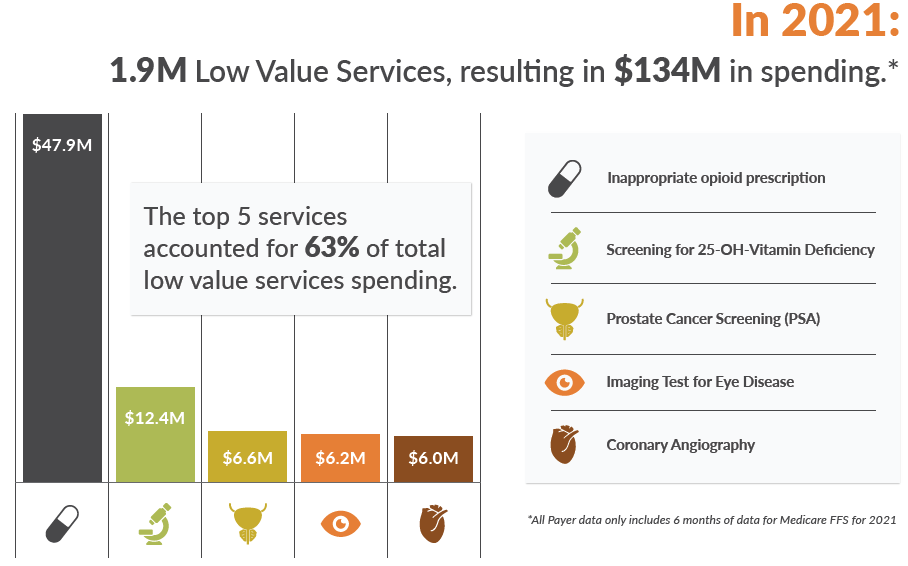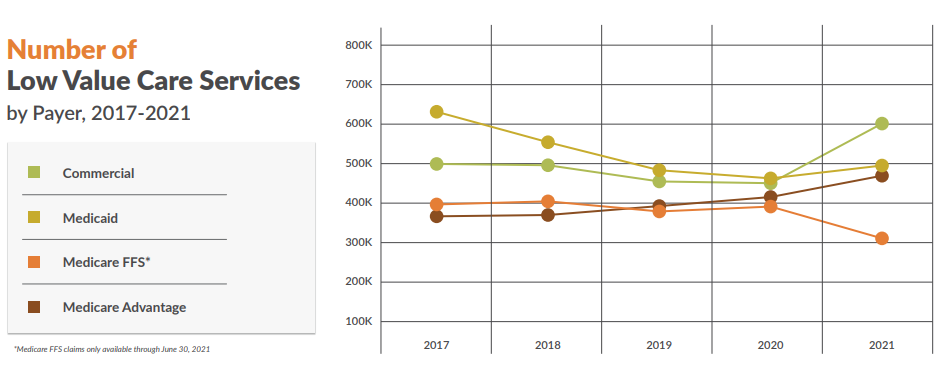Unnecessary and Potentially Harmful Care Costs Payers and Patients $134 Million Annually
A new analysis released by the Center for Improving Value in Health Care (CIVHC) shows that in 2021, Coloradans received nearly two million potentially unnecessary health care services costing patients and health insurers approximately $134 million. Of the 58 services evaluated statewide, inappropriate opioid prescribing was the top service by spend, and resulted in nearly $48 million, or 36% of all low value spending.
Low value health care services are certain treatments, diagnostic tests, and screenings where the risk of harm or cost exceeds the likely benefit for patients. Medical boards, societies, and providers across the U.S. collectively identify and share information about these low value services through a campaign called Choosing Wisely.
The most recent analysis of low value care in Colorado was conducted using claims from the Colorado All Payer Claims Database (CO APCD) from 2017 to 2021. CIVHC partnered with Milliman to evaluate potentially low value services that can be identified with claims through Milliman’s MedInsight Health Waste Calculator software.
Across all payers, the top five services by spend accounted for 63% of the total low value care spending for the state. Prescribing opioids for treatment of chronic, non-cancer related pain resulted in the highest spend in 2021 ($48M), followed by screening for Vitamin D deficiency ($12M), routine prostate cancer screening in men with no symptoms of disease ($6.6M), imaging tests for people without symptoms or signs of significant eye disease ($6.2M), and coronary angiographies to assess risk in asymptomatic patients ($6M).
“This most recent analysis puts crucial information into the hands of the people who need it most,” states Kristin Paulson, President and CEO of CIVHC. “Understanding the most frequent low value services occurring in Colorado and how much they cost can help health insurance companies, providers, and patients work together to improve care and lower costs.”

On average, the low value services analyzed cost $70 per instance, but some, like proton beam therapy for prostate cancer, can cost almost $19,000 per treatment or procedure. In addition to being costly to patients and insurers, many of the low value care services, like unnecessary screenings, can actually harm patients physically and/or emotionally through false negatives that result in more unnecessary testing. Or, in the case of inappropriate opioid prescribing, the risk of harm is high and has the potential to result in addiction and death.
The free, interactive report allows users to look at low value services over time, by health insurance payer type, and across different regions in Colorado. The graphic below shows how the total number of low value services has changed over time by payer type. For the 58 services evaluated, the total number decreased the most from 2017 to 2020 for Medicaid members compared to other payers.


Top services by spending also vary across payer type due to the different demographics they serve. Interestingly, Medicare Fee-for-Service and Medicare Advantage, payers that typically cover the same age groups, do not have the same top three low value services by spend with the exception of colorectal screenings in adults over 50. This may be due to differences in coverage and/or reimbursement rates.
Efforts to reduce low value care that have had positive results in other states include provider-focused and patient education interventions as well as multi-stakeholder collaborations. Initiatives are most effective when each unique low value care service is evaluated individually based on the patient diagnosis and history, patient expectations regarding treatment, and payment incentives. Challenges to addressing low value care include provider time constraints and overcoming patient preferences and expectations.
This analysis provides valuable insights on ways to address both health care spending and patient outcomes. CIVHC is able to provide data specific to individual providers, payers, employer groups and communities to inform improvement activities at the local level. If you are interested in understanding low value care for your community or patient population, please contact us at info@civhc.org.
Related Resources:
